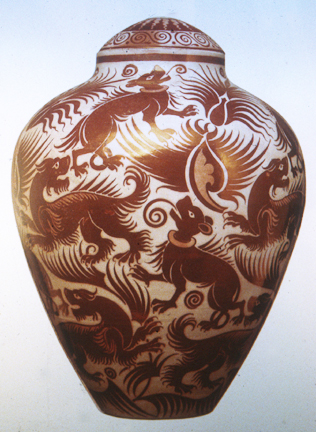William de Morgan was, in his own words, very interested in 'learning
the lost art of Moorish and Gubbio lusters.' Ill health forced him to begin
spending his winters in Italy to avoid the harsh English climate and he
began making and firing pottery in a rented studio near Florence. His production
was small and never a financial success, but he did succeed in reproducing
the beautiful ruby red lusters in the Hispano-Moresque style. His experiments
with luster caused Wedgewood to take notice, and the Etruria factory soon
began to produce luster ware. The contemporary potter, Alan Caiger-Smith
(author of Luster Pottery) also points to de Morgan's experiments
as the basis for his interest in lusterware. This covered jar by de Morgan
shows his success in the creation of ruby lusters and his interest in all-over
Persian design. Like William Morris, William de Morgan was in great demand
on the lecture circuit, and his contributions to the spirit of the Arts
and Crafts Movement are well documented. In later life, when he was no longer
able to make pottery, he began another career, this time as a novelist,
and he had great success, especially with his novel, Joseph Vance.

'Covered Vase, by William de Morgan
Earthenware with Luster Design, 14" height, 1890


